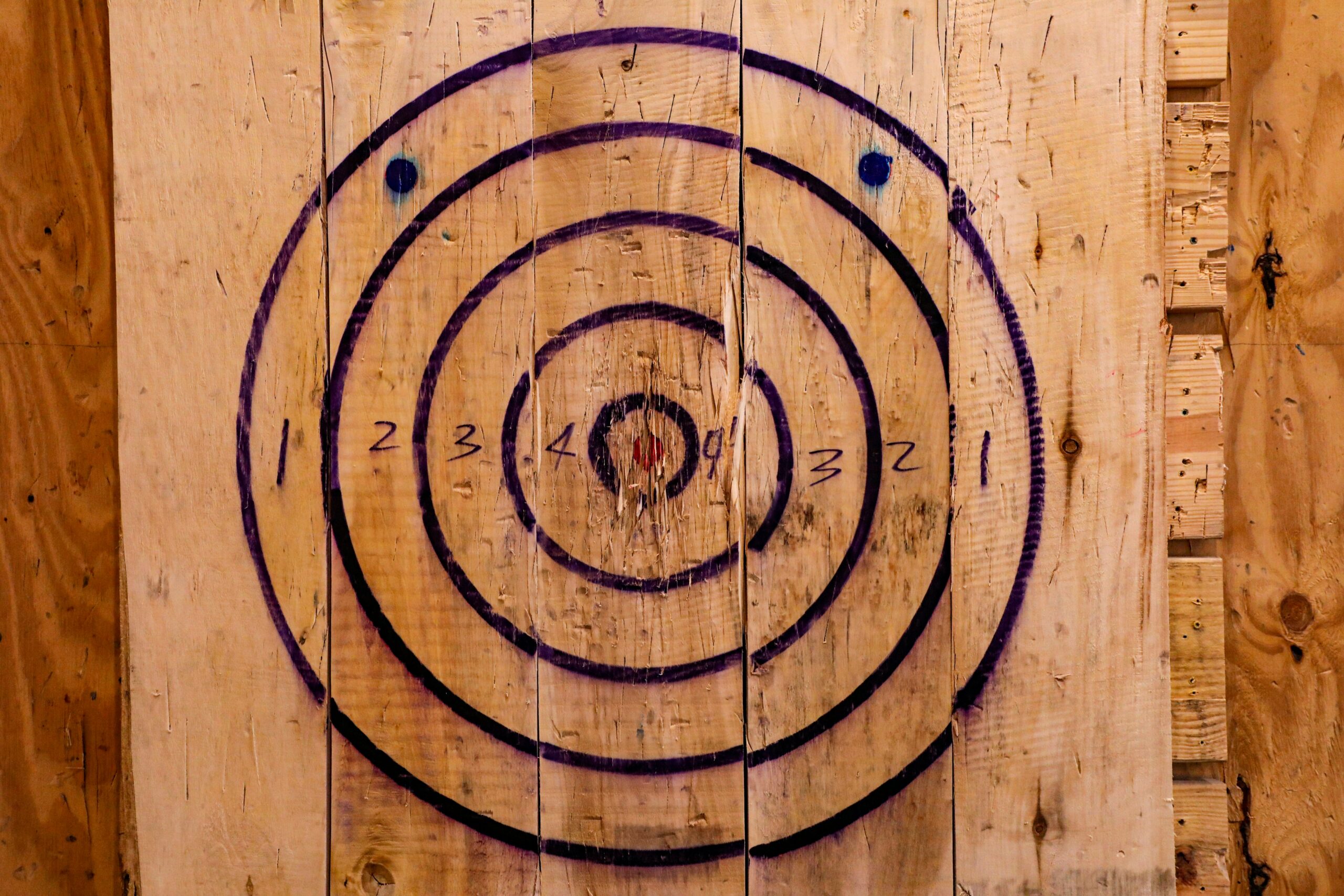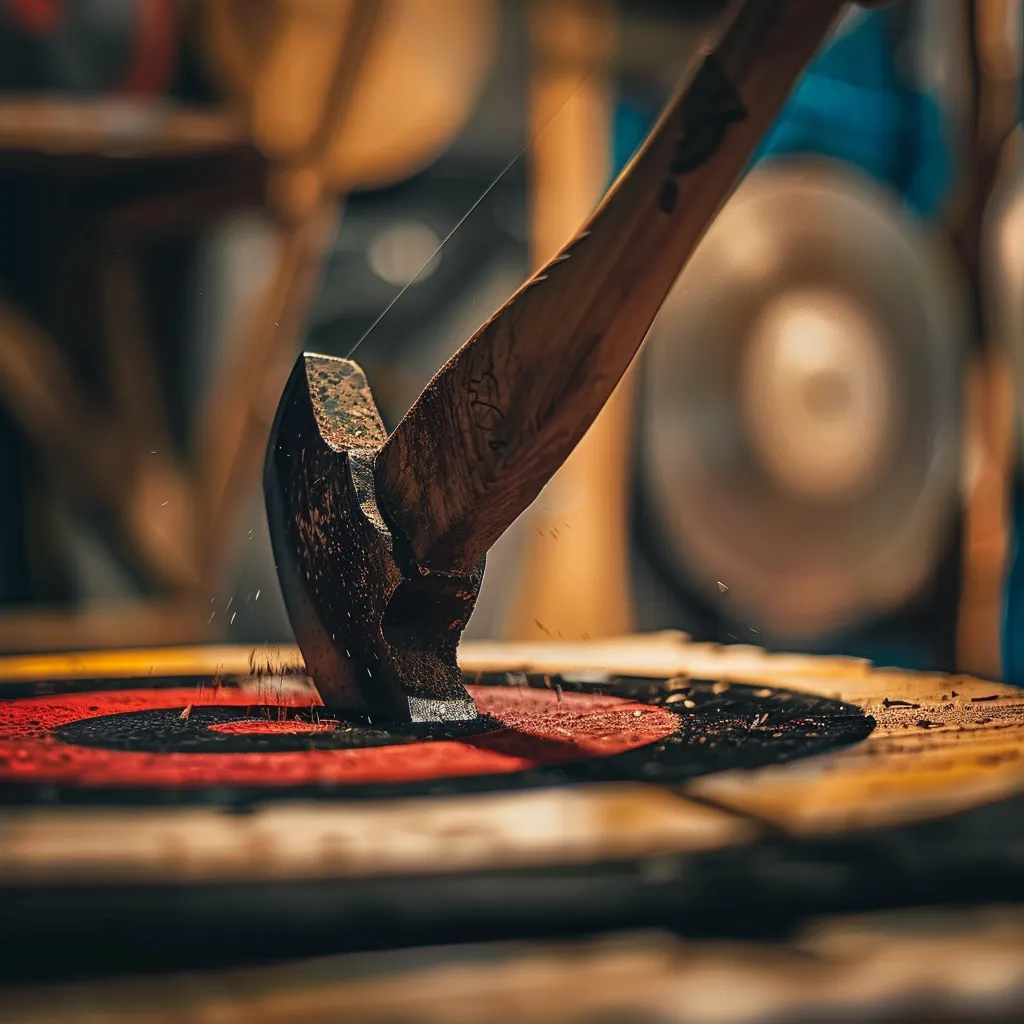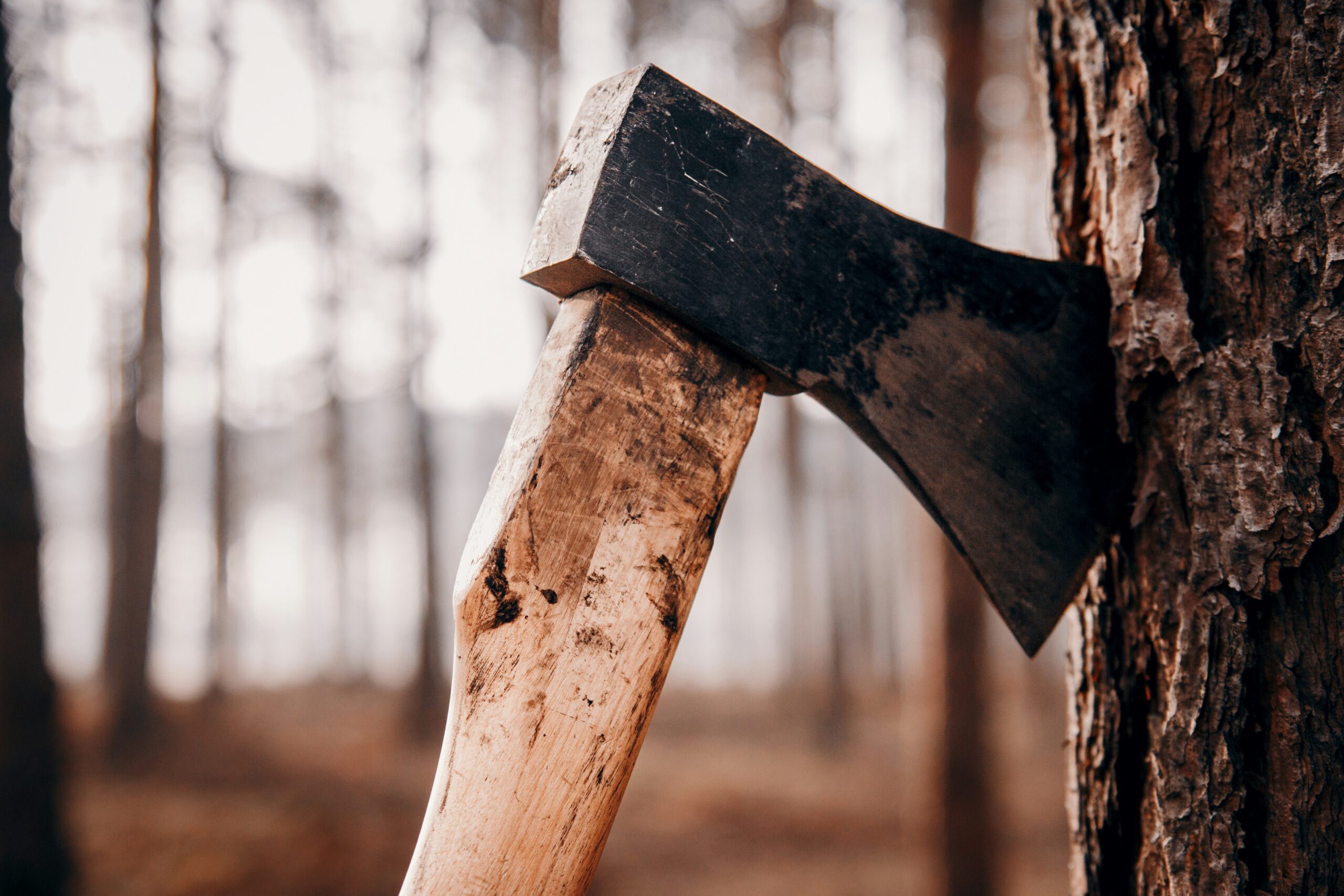Are you ready to dominate your next axe-throwing competition? This guide will equip you with essential axe throwing strategies to improve your accuracy, power, and mental focus. We’ll cover choosing the right axe weight, perfecting your throwing technique, and maintaining safety during practice.
Learn how to sharpen your skills with target practice and how to stay focused during high-pressure moments. Whether you’re fine-tuning your skills or starting fresh, these tips will help you stand out in competitive axe throwing.
Key Takeaways
- Master fundamental techniques, rules, and scoring systems to build a strong foundation for competitive axe-throwing
- Develop effective practice routines, set clear goals, and seek feedback to improve skills continuously
- Cultivate mental focus, manage stress, and utilize visualization techniques to enhance performance during competitions
- Adapt to different environments, read opponents, and stay updated with industry trends for a competitive edge
- Select and customize the right axe, understanding specifications and regulations for optimal performance in tournaments
Understanding the Fundamentals of Competitive Axe Throwing

Competitive axe throwing demands a solid grasp of fundamentals. Throwers must understand the rules and scoring systems, including point allocation and sudden-death scenarios. Familiarity with various competition formats is crucial, as is adhering to safety protocols. From proper foot placement to the smooth motion of throwing, mastering these basics forms the foundation for success in this exciting sport.
Grasping the Rules and Scoring Systems in Competitions
Competitive axe-throwing rules and scoring systems are designed to test a thrower’s precision and consistency. Participants aim for the bullseye, which typically awards five points, with decreasing scores for outer rings.
A thrower’s hand and shoulder positioning are crucial for accuracy, while proper gear ensures safety. Stepping over the fault line results in a zero score, emphasizing the importance of foot placement during throws.
Familiarizing Yourself With Different Competition Formats
Axe throwers must familiarize themselves with various competition formats to excel in the sport. The World Axe Throwing League (WATL) and other organizations offer different event structures, including individual matches, team competitions, and tournament-style events.
Throwers should practice their grip and throwing techniques for both standard targets and specialty boards, which may incorporate elements similar to darts. Gaining experience in diverse formats enhances adaptability and prepares competitors for any challenge they may face:
- Individual matches: One-on-one competitions
- Team events: Collaborative throwing challenges
- Tournament brackets: Progressive elimination rounds
- Specialty target games: Unique scoring systems and board layouts
Recognizing the Importance of Safety Protocols
Safety protocols are paramount in competitive axe throwing tournaments, ensuring the well-being of participants and spectators alike. Throwers must maintain proper muscle control and form to prevent accidents, while adhering to strict guidelines regarding axe dimensions and weight. Teamwork is essential in upholding safety standards, with spotters and officials working together to create a secure environment for this thrilling sport.
Developing Precise Throwing Techniques

Developing precise throwing techniques is crucial for axe-throwing competitors. This section covers mastering the grip for optimal control, perfecting stance and footwork, practicing both one-handed and two-handed throws, and refining release timing.
These skills help throwers improve accuracy, consistency, and overall performance. Proper technique enhances muscle memory, allowing competitors to adjust their throwing angle based on feedback for better results.
Mastering the Grip for Optimal Control
Mastering the grip is crucial for optimal control in competitive axe throwing. A consistent hold on the axe handle is key, with competitors wrapping their fingers around the handle and leaving enough room at the end for a clean release. Marking the ideal grip position on the wood handle can help throwers maintain consistency across multiple throws during competitions.
Perfecting Your Stance and Footwork
Perfecting stance and footwork is crucial for competitive axe throwing. Throwers should position their feet shoulder-width apart, with the dominant foot slightly forward, to create a stable base for the throwing motion.
This stance allows for optimal arm movement and eye alignment, ensuring a smooth release and accurate trajectory. By practicing consistent foot placement and body positioning, competitors can improve their overall performance in this dynamic sport.
Practicing One-Handed and Two-Handed Throws
Mastering both one-handed and two-handed throws is essential for competitive axe throwers. The one-handed technique, often favored by lumberjacks, requires precise control of the throwing axe’s rotation, while the two-handed approach provides more power and stability.
Competitors must practice both methods to adapt to different hatchet weights and target distances in various competitions. By honing these techniques, throwers can improve their accuracy and consistency, giving them an edge in high-stakes tournaments.
Refining Release Timing for Consistent Accuracy
Refining release timing is crucial for consistent accuracy in axe throwing. Competitors must develop muscle memory to release the handle at the optimal point in their throwing motion, ensuring the axe rotates correctly and strikes the target with precision.
By focusing on elbow positioning and maintaining a smooth, fluid motion, throwers can improve their accuracy and consistency. Regular practice helps build the necessary muscle memory for consistent performance in competitions:
- Develop a consistent throwing motion
- Focus on elbow positioning during release
- Practice releasing at different points to find the optimal timing
- Use visualization techniques to reinforce proper release timing
Choosing the Right Axe for Competition

Selecting the right axe is crucial for competitive success. Throwers must evaluate different axe types, understand specifications and regulations, customize for comfort, and maintain their equipment.
The right axe enhances skill and performance, with factors like length and weight affecting the throwing technique. Proper maintenance ensures peak performance during competitions.
Evaluating Different Axe Types and Their Benefits
Competitive axe throwers must carefully evaluate different axe types to find the one that best suits their throwing style and competition needs. Hatchets, being lighter and more maneuverable, excel in precision throws, while larger felling axes provide more power for longer distances.
Some throwers prefer double-bit axes for their balanced weight distribution, which enhances rotation control. Understanding the benefits of each type allows competitors to select the optimal tool for their skill level and competition format, potentially giving them an edge in tournaments.
Understanding Axe Specifications and Regulations
Competitive axe throwers must adhere to strict specifications and regulations set by governing bodies like the World Axe Throwing League. These guidelines typically dictate acceptable axe weights, lengths, and head sizes to ensure fair competition.
For example, many leagues require axes to weigh between 1.5 and 2.5 pounds, with a handle length of 13 to 19 inches. Understanding these regulations helps competitors select appropriate axes and avoid disqualification during tournaments.
Customizing Your Axe for Personal Comfort
Customizing an axe for personal comfort is crucial for competitive axe throwers. Adjustments to the handle length, grip texture, and weight distribution can significantly improve a thrower’s performance.
Many competitors wrap their axe handles with tennis grip tape or add custom finger grooves to enhance control and reduce hand fatigue during extended practice sessions or tournaments. Some even modify the axe head’s weight or shape to achieve optimal rotation and stick:
Maintaining Your Axe for Peak Performance
Maintaining an axe for peak performance is crucial for competitive throwers. Regular sharpening of the blade ensures clean cuts and precise sticking while oiling the handle prevents splinters and maintains a consistent grip.
Competitors should inspect their axes before each throwing session, tightening any loose parts and replacing damaged components to ensure safety and optimal performance during competitions.
Building an Effective Practice Routine
Building an effective practice routine is crucial for axe-throwing competitors. This section covers setting clear goals, incorporating skill-enhancing drills, analyzing techniques, and seeking feedback. These elements help throwers track progress, improve skills, make necessary adjustments, and benefit from expert insights, ultimately enhancing their competitive performance.
Setting Clear Goals to Track Progress
Setting clear goals is essential for axe throwers to track their progress effectively. Competitors should establish specific, measurable objectives for accuracy, consistency, and throwing speed. By breaking down long-term goals into smaller, achievable milestones, throwers can monitor their improvement over time and stay motivated. A well-structured goal-setting system helps throwers identify areas for improvement and adjust their practice routines accordingly:
Incorporating Drills to Enhance Skills
Incorporating targeted drills into practice routines is essential for enhancing axe-throwing skills. Competitors should focus on exercises that improve accuracy, consistency, and throwing speed.
Examples include distance variation drills, blind throws, and rapid-fire sessions. These exercises help throwers develop muscle memory, adapt to different target distances, and improve their overall performance in competitions:
Analyzing Throwing Techniques and Making Adjustments
Analyzing throwing techniques and making adjustments is crucial for competitive axe throwers. They should regularly review video footage of their throws to identify areas for improvement, such as arm positioning, release point, and follow-through.
By breaking down each component of their throw, competitors can pinpoint weaknesses and develop targeted practice strategies to address them. Seeking feedback from experienced throwers or coaches can provide valuable insights and help refine techniques for optimal performance.
Seeking Feedback From Coaches and Peers
Seeking feedback from coaches and peers is crucial for axe throwers looking to improve their competitive performance. Experienced coaches can provide valuable insights on technique refinement, mental preparation, and competition strategies.
Fellow competitors offer a unique perspective, sharing their own experiences and observations. By actively seeking and implementing feedback, throwers can identify blind spots in their technique, make necessary adjustments, and accelerate their progress in the sport.
Conclusion
Mastering axe throwing requires a comprehensive approach, combining physical skills with mental preparation and strategic thinking. Competitors must develop precise throwing techniques, choose the right equipment, and build effective practice routines to hone their abilities.
Mental preparation, including stress management and visualization, plays a crucial role in maintaining focus and confidence during high-pressure competitions. By staying updated with industry trends and employing advanced strategies, axe throwers can gain a competitive edge and excel in this challenging sport.

